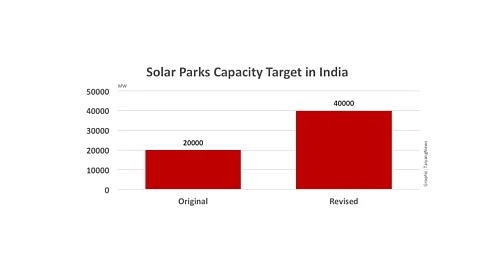India Doubles Solar Park Target
- SunEdison debacle and slow response to rooftop solar is pushing Indian Government to double solar park capacity target from 20,000 to 40,000 MW
- Solar parks are the preferred solar investment with developers as the government takes care of land and transmission issues
- The proposal to increase capacity is waiting approval from the Prime Minister's Cabinet
The uncertain future of the solar portfolio held by bankrupt SunEdison's and the un-enthusiastic response to rooftop solar has finally pushed the Indian government to react. Speaking to Reuters, Secretary at Ministry of New and Renewable Energy (MNRE) Upendra Tripathy stated these are the reasons for India having decided to double the target for solar power from solar parks by 2020 to 40,000 MW. This goal is pending approval from the Indian cabinet led by Prime Minister Narendra Modi.
SunEdison's debacle in the US has started to affect its Indian portfolio. It recently sold its 7 MW rooftop capacity in India to Amplus Energy. There have been rumours about the company being in talks with various big names to sell its Indian solar projects (see New Rumors About SunEdison's India Assets). Though Minister for New and Renewable Energy Piyush Goyal had in the past rubbished rumours about SunEdison fiasco affecting Indian solar industry (see Large Scale Solar In India), it seems the ministry is now reacting to the challenge SunEdison's bankruptcy is posing for its Indian portfolio.
There are several other foreign companies that are reported to invest in the Indian solar space, including Finland's Fortum, Japan's SoftBank along with Foxconn and Bharti Enterprises, and some Chinese companies as well.
The senior official was quoted by Reuters as saying, "We are adding 25 more solar parks to create a buffer for exigencies like SunEdison."
As the government provides land for solar parks in India, developers do not encounter problems in land acquisition or building transmission lines, which is otherwise a challenge in India. Due to this, solar parks are preferred solar investments by developers, according to Tripathy.
In the first phase, the ministry was aiming to have 25 solar parks each with a capacity of 500 MW and above. This would have lead to 20,000 MW of solar power capacity from fiscal years 2014-15 to 2018-19. By April 2016, the number of solar park projects had increased to 33 in 21 states. In a second phase of the solar parks project, the administration will have developers arrange for 200 to 300 MW of storage capacity.


.png?w=50&fm=png)